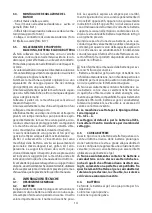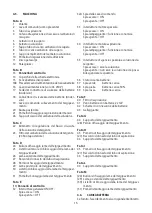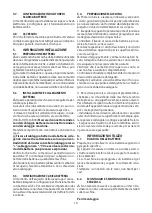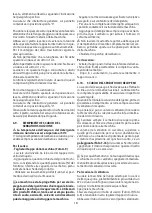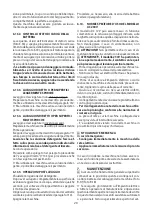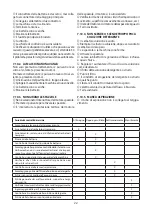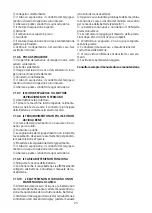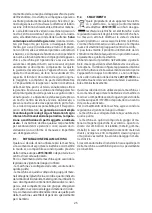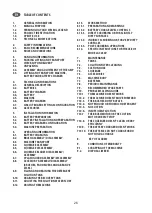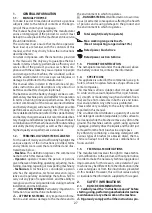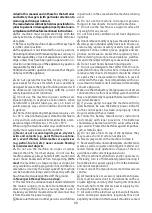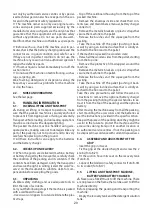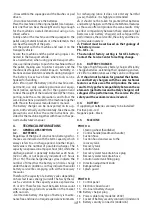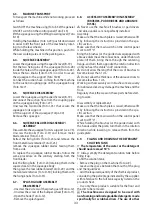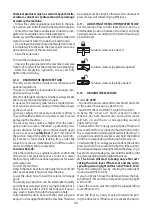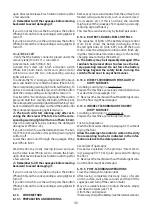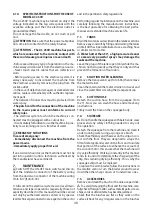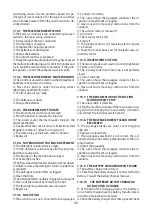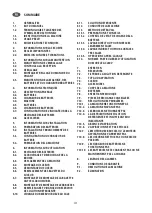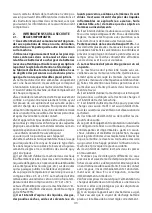
28
vided in this manual and in those for the batteries
and battery chargers (with particular attention to
warnings and danger notices).
The manufacturer will not be held responsible for in-
juries to persons or damage to property due to non-
compliance with the aforementioned instructions.
•
This machine must be powered only with the
safety extra-low voltage indicated on the technical
data plate.
☞
Before using the machine, make sure that each part
is in the correct position.
•
The appliance is not intended for use by persons
(including children) with reduced physical, sensory or
mental capabilities, or lack of experience and knowl-
edge, unless they have been given supervision or in-
struction concerning use of the appliance by a person
responsible for their safety.
Children should be supervised to ensure that they do
not play with the appliance.
•
Do not operate this machine for any other pur-
pose except for the use for which it was specifically
designed. Evaluate the type of building where it will
be utilised and rigorously comply with the current
safety regulations and conditions.
•
Do not use the machine in places without ad-
equate lighting, in explosive environments, when
harmful dirt is present (dust, gas, etc.), on roads or
public passage ways and in outdoor environments
in general.
•
The machine operating temperature range is +4°C
to + 35°C; when not being used, store the machine in
a dry and non-corrosive environment within a tem-
perature range of b 10°C and + 50°C.
When using the machine under any condition the hu-
midity must range between 30% and 95%.
•
Never use or vacuum liquids, gases, dry dust,
acids and solvents (e.g. paint thinners, acetone,
etc.), even if diluted, inflammables or explosives
(e.g. petrol, fuel oil, etc.); never vacuum flaming
or incandescent objects.
•
Do not use the machine on slopes or ramps
steeper than 2%; for small slopes, do not use the
machine sideways, always handle it with caution and
never move backwards. When transporting (10%
max) the machine on steeper ramps or slopes, be
very careful to avoid tipping and/or uncontrolled ac-
celerations . Use only the lowest speed! The machine
can be handled on ramps and/or steps only with the
brush head and squeegee lifted off the ground.
•
Never park the machine on a slope.
☞
The machine should never be left unattended with
the motors running; it can be left unattended only
after turning off the motors, ensuring that it won’t
make any accidental movements and disconnecting
it from the electric power supply.
•
Make sure there are no other persons, and children
in particular, in the area where the machine is being
used.
•
Do not use the machine to transport persons/
things or to tow objects. Do not tow the machine.
☞
Do not use the machine as a support surface for
any weight for any reason.
Do not block the ventilation and heat dispersion
openings.
•
Do not remove, modify or by-pass the safety devices.
•
Always use individual safety devices to ensure op-
erator safety: aprons or safety overalls, non-slip and
waterproof shoes, rubber gloves, goggles and ear-
phones, and masks to protect the respiratory tract.
Before starting to work, remove necklaces, watches,
ties and other objects that may cause serious injuries.
•
Do not insert hands between moving parts.
☞
Do not use detergents that differ from those re-
quired and follow the instructions indicated on the
relative safety sheets. Detergents should be stored
in a place that is inaccessible to children. In case of
contact with the eyes, rinse immediately with copi-
ous amounts of water and, if swallowed, immediately
consult a physician.
Make sure that the battery charger power sockets are
connected to an efficient earthing system and that
they are protected by magnetothermal and differen-
tial circuit-breakers.
•
If you are going to equip the machine with dry
(gel) batteries, be sure the battery power indicator
on the control panel, has been set properly. Check
this procedure with your dealer.
•
Follow the battery manufacturer’s instructions
and comply with legal provisions. The batteries
should always be clean and dry to avoid surface leak-
age currents. Protect the batteries against impurities,
such as metallic dust.
•
Do not place tools on top of the batteries: they
may cause a short-circuit or an explosion.
•
Never spray water on the machine to clean it.
☞
Recovered fluids contain detergents, disinfectants,
water, as well as organic and inorganic material col-
lected during work operations: dispose of them in
accordance with current legal provisions.
•
If the machine malfunctions and/or operates in-
efficiently, turn it off immediately (disconnecting it
from the electric power supply or from the batteries)
and do not tamper with it.
Contact one of the manufacturer’s technical service
centres.
•
All maintenance or accessory replacement opera-
tions must be carried out in environments with ad-
equate lighting and only after having disconnected
the machine from the electric power supply by de-
taching the battery connector.
☞
All work on the electrical system and all mainte-
nance and repair operations (especially those not
explicitly described in this manual) should be carried
Summary of Contents for CPS 45 BX
Page 3: ...A 3 3 4 5 6 7 8 9 10 12 11 1 2 40...
Page 5: ...C 22 23 20 20 5...
Page 6: ...6 D 24 28 31 25 26 27 29 30...
Page 7: ...7 E Model AC 230V Model 2 x DC 12 V F 33 33 34 34 35 35 37 36 38 39 32 32 32A 40 41 42 43 13...
Page 8: ...8 G I H L 44 28 44 27 27 44 45 44 45...
Page 9: ...9 M 24 29 30 31...
Page 88: ...88 46 33 34 35 A 1 B 19 E 35 A 1 B 19 E 35 E 33 E 33 E 34 A 2 C 22 E 35 B 19 A 2 E 33 E 34...
Page 89: ...89...
Page 90: ...90...
Page 91: ...91...
Page 92: ...92...
Page 93: ...93...
Page 94: ...94...
Page 95: ...95...
Page 97: ...97 1 1 1 1 2 2 10 1 3 1 4...
Page 98: ...98 1 5 2 2 1 4 C e 35 C 10 50 30 95 2 10...
Page 99: ...99 2 2 3 3 1 3 2...
Page 100: ...100 3 3 3 4 B 21 A 3 Anderson B 18 B 18 3 5 4 4 1 4 2 20 20 20 5 C5 5...
Page 103: ...103 5 4 6 6 1 6 2 7 B 19 A 1 C 20 E 32 E 13 E 33 A 2 1 1 B 19 A 1 E 35 6 3...
Page 105: ...105 A 9 2 B 46 6 10 F 43 A 7 A 8 6 11...
Page 107: ...107 6 13 3 7 7 12 6 13 4 7 11 7 13 3 6 13 5 7 10 6 14 AC 230V DC12V 230V 7 B 17 B 18...
Page 108: ...108 7 1 50 7 2 C 23 7 3 H 27 7 4 7 5 7 6 7 7 7 8 3 AGM 6 7 9...
Page 109: ...109 7 10 7 10 1 30 7 10 2 2 2 7 10 3 7 10 4 X X X X X X X X X X X X X X X X...
Page 110: ...110 7 10 5 7 10 6 7 10 7 7 10 8 7 10 9 7 10 10 8 7 100 20 30...
Page 111: ...111 I2T E33 800 E33 I2T E34 800 E34 80 C E33 E34 E38 400 E38 100 E38...
Page 112: ...112 8 9 12 9 1 2013 56 EU 9 2 2012 19 EU 2012 19 EU...
Page 230: ...230 1 1 1 1 2 2 10 1 3 1 4...
Page 231: ...231 1 5 2 2 1 4 C 35 C 10 C 50 C 30 95 2 10...
Page 232: ...232 2 2 3 3 1 3 2 3 3...
Page 233: ...233 3 4 B 21 B 3 Anderson B 18 B 17 3 5 4 4 1 4 2 Ah 20 C20 20h 5 C5 5h C5 C20...
Page 241: ...241 7 3 H 27 7 4 7 5 7 6 7 7 7 8 X X X X X X X X X X X X X X X X...
Page 242: ...242 7 10 4 7 10 5 7 10 6 3 AGM 6 7 9 7 10 7 10 1 30 7 10 2 2 7 10 3...
Page 243: ...243 7 10 7 7 10 8 7 10 9 7 10 10 8 7 100 20 30...
Page 245: ...245 9 12 9 1 2013 56 9 2 WEEE 2012 19 2012 19...
Page 246: ......
Page 247: ......
Page 248: ......
Page 252: ...cod 7 504 0291 rev 04 09 2021...

